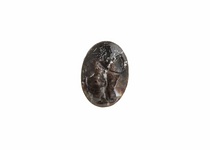| Collection: | Corinth | |
| Type: | Basket | |
| Name: | Nezi Field, context 1151 | |
| Area: | Nezi Field | |
| Title: | Levelling fill N of wall 1155 and E of wall 1154 | |
| Category: | Deposit | |
| Notebook: | 1107 | |
| Context: | 1151 | |
| Page: | 0 | |
| Date: | 2013/05/29 | |
| Stratum: | Inclusions of tile, mudbrick, ceramic, glass, metal, charcoal, fine, medium, and coarse pebbles, cobbles, some boulders (about 50% total) | |
| Description: | Top slope of the context is level. The soil color is light reddish brown. The soil compaction is soft. The soil is very poorly sorted. It is sandy clay. | |
| Notes: | This deposit is located in the western half of the space enclosed by wall 1155 to the south, wall 1154 to the west, wall 5435 to the east, and a previously excavated trench to the north (not dug since 1961). This deposit is distinguished from the soil in the eastern half of the space by its reddish color. The soil is generally soft with some patches of firmer, more clay-rich sediment. Stones range in size from pebbles to boulders and are mostly angular and tabular. Broken tiles make up a large fraction of total inclusions. These range in size from approximately 30 x 45 x 4.5 cm to approximately 4 x 3 x 2 cm. Most appear to be Roman, but some earlier (Classical?) painted tiles are also present. Mudbrick is another major component of the inclusions. Most was fragmentary, but one large piece (6 x 16 x 10 cm) had one, possibly two, edges preserved. Since mudbrick this complete is rare, this piece was taken back to the museum and may be used for a thin section (Museum Basement, Samples Drawer 293). The reddish color of the soil may be a result of the mudbrick having been exposed to heat. Charcoal inclusions in the deposit support this idea. Other finds include a piece of purple and white marble, worked, and a carved oval gemstone approximately one centimeter in length, discovered during dry sieving. The gem is darkish grey with stripes (possibly an agate) and depicts an armed Aphrodite holding out her shield and looking at her reflection in it. According to Guy, this version of Aprhodite is particular to Corinth and has not been discovered on a gemstone before. The gem likely dates to the Roman period. This deposit is probably leveling fill. The pottery has not been read yet, but it appears to be a mix of material from different periods. The large amount of broken tiles and mudbricks may indicate that the fill contains part of a collapsed building. The area to the west of this deposit was excavated in 2007. We hope to compare the nature of the deposits on either side of wall 1154 and to see what deposits lie below this fill layer. We continued to excavate this deposit on May 30 and recovered several corroded iron objects (probably nails). As we went down in elevation, we noticed fewer broken tiles and cobbles and less mudbrick. Context 1151 ended on top of a hard-packed, fine-grained surface -- probably an earthen floor. The floor appears to predate wall 1155 (which sits above it on top of a balk of earth) and to postdate or be contemporaneous with wall 1154. 20/6: On examining the southern section, deposit 1151 does appear to continue below structure 1155 to the souht, but not all the way to the other side past the S face of 1555. In order to determine the southernmost extend of 1151, we would need to remove wall 1155. In any case, it appears that 1155 overlays (and thereby postdates) 1151. | |
| Context Pottery: | Fineware. Arretine, unidentified. 2 bodysherds. ; Fineware. Pre-Roman158 bodysherds. | |
| Pottery Summary: | 158 frag(s) 0.25 kg. (0% saved) fineware. | |
| 254 frag(s) 2.34 kg. (0% saved) coarseware. | ||
| 166 frag(s) 0.84 kg. (0% saved) cooking ware. | ||
| Context Artifacts: | Glass, clear amber: bs 1; 1 mudbrick, dim. 0.15 x 0.10 x 0.08, 2 edges preserved; Glass, clear light blue: base 1, diam. 0.038, folded and tubular; Glass, clear colorless: bs 22, rim 4 (3 inward thickened, 1 folded and tubular); Plaster: 4 black, 1 red and white, 11 red, 4 yellow; Worked purple and white marble, oval; Glass, clear dark grey: bs 1; Glass, clear colorless: rim 3, folded and ovoid tubular, from same vessel, diam. 0.10; Iron: 4 nails, 6 round shafts, 1 square shaft, 2 tacks, 6 slag; Glass, clear amber: sectile fragment? (see MF-71-217); Agate gemstone (inventoried) | |
| Chronology: | Middle to Late Roman, npd | |
| Grid: | 269.95-268.84E, 1020.54-1022.2N | |
| XMin: | 268.84 | |
| XMax: | 269.95 | |
| YMin: | 1020.54 | |
| YMax: | 1022.2 | |
| Site: | Corinth | |
| City: | Ancient Corinth | |
| Country: | Greece | |
| Masl: | 84.96-85.36m. | |
| References: | Object: MF 2013 13 |
|
References Classifications Sign in Provide feedback |
|
